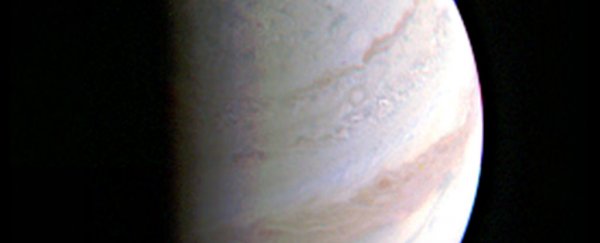NASA's Juno spacecraft just completed a record-breaking flyby of Jupiter, snapping some incredible pictures as it soared over the tops of the gas giant's clouds at speeds of around 209,200 km/h (130,000 mph).
Now that Juno has finally reached its destination, after spending the last five years and 2.9 billion km (1.8 billion miles) in transit, it's scheduled to complete 35 more flybys of Jupiter over the next 18 months.
"Early post-flyby telemetry indicates that everything worked as planned and Juno is firing on all cylinders," said Juno's project manager, Rick Nybakken.
According to NASA, Juno successfully executed its first flyby on August 27 at 6:44am PDT (13:44 UTC), getting within 4,184 km (2,600 miles) above Jupiter's swirling clouds.
At that moment, the spacecraft kicked nine different on-board instruments into gear, capturing close-up images with JunoCam - its panoramic colour camera.
The images are expected to be released by NASA later this week, but you can see one in the tweet below, taken when Juno was at 703,000 km (437,000 miles) away from Jupiter.
Information about Jupiter's gravity, magnetic field, chemical composition, and what's behind its 617-km/h (384-mph) winds will be analysed as it's downloaded from the craft.
"We are getting some intriguing early data returns as we speak," Scott Bolton, principal investigator of Juno from the Southwest Research Institute in San Antonio, told the press.
"It will take days for all the data to be downlinked, and even more to begin to comprehend what Juno and Jupiter are trying to tell us. This is our first opportunity to really take a close-up look at the king of our Solar System and begin to figure out how he works."
Soarin' over #Jupiter. My 1st up-close look of the gas-giant world was a success! https://t.co/5DghesSgvY pic.twitter.com/BTbhOD8rJy
— NASA's Juno Mission (@NASAJuno) August 27, 2016
If you're secretly not that impressed that 4,184 km above the clouds of Jupiter is the best we can do, consider that the previous record for the closest approach of the planet was set by NASA's Pioneer 11 spacecraft back in 1974, when it got within 43,452 km (27,000 miles) of the atmosphere.
Since then, we've managed to get NASA's Galileo spacecraft right into Jupiter's atmosphere, where it spontaneously combusted, thanks to the planet's super-powerful radiation belts.
Before Galileo was deliberately flown into the Solar System's incinerating machine - better than having it fly around as space junk for the foreseeable future - it orbited the planet at a distance of about 200,000 km (130,000 miles).
Jupiter's radiation belts are similar to the Van Allen belts around Earth, but are much more intense, given the fact that Jupiter's magnetic field is around 20,000 times more powerful than Earth's.
In this region, electrons and ions are collected from incoming solar winds and trapped within the magnetic field, where they're accelerated to nearly the speed of light, and delivered to Jupiter's poles to produce massive solar storms and some incredibly colourful aurorae.
"Once these electrons hit a spacecraft, they immediately begin to ricochet and release energy, creating secondary photons and particles, which then ricochet," Heidi Becker, leader of Juno's radiation-monitoring team, told Mike Wall at Space.com in July. "It's like a spray of radiation bullets."
The radiation in Jupiter's radiation belts is at its harshest within about 300,000 kilometres (about 200,000 miles) of the planet, so the fact that Juno is expected to have to withstand all that for the next 18 months is pretty damn impressive.
We do feel slightly bad for some of its cargo though - those titanium Lego models of Galileo Galilei, and the goddess Juno and her husband Jupiter are probably having a pretty bad time of it.
Sad Lego deaths aside, let's hope for some more amazing results from Juno in the coming months. We can't wait to see what little Juno serves up next.
As NASA's Scott Bolton said over the weekend: "We are in an orbit nobody has ever been in before, and these images give us a whole new perspective on this gas-giant world."
